Splay
呜呼今天终于搞懂splay了
学习之前你需要知道的
这东西深度并不是 logn 的,但是复杂度是均摊 O(nlogn+mlogn) 的 初学者可能会把它当做一个平衡树
基础的函数
1
2
3
4
5
6
7
|
inline void pushup(int x){sz[x]=sz[ls]+sz[rs]+cnt[x];}
inline int pd(int x){return c[f[x]][1]==x;}
inline void clear(int x){ls=rs=sz[x]=f[x]=val[x]=cnt[x]=0;}
|
splay的函数
rotate
1
2
3
4
5
6
7
8
9
10
11
12
| void rotate(int x)
{
int y=f[x],z=f[y],k=pd(x),m=c[x][!k];
c[y][k]=m; c[x][!k]=y; f[m]=y; f[y]=x; f[x]=z;
if(z) c[z][c[z][1]==y]=x;
pushup(x);
pushup(y);
}
|
splay
1
2
3
4
5
6
7
8
9
10
11
| void splay(int x)
{
for(int y=f[x];y=f[x],y;rotate(x))
{
if(f[y]) rotate(pd(x)^pd(y)?x:y);
rt=x;
}
}
|
BST函数
insert
1
2
3
4
5
6
7
8
9
10
11
12
13
14
15
16
17
18
19
20
21
22
23
24
25
26
27
28
29
30
31
32
33
34
35
36
37
| void insert_tree(int target)
{
int x=rt,fat=0;
if(!rt)
{
val[++tot]=target;
cnt[tot]++;
rt=tot;
pushup(rt);
return ;
}
while(1)
{
if(val[x]==target)
{
cnt[x]++;
pushup(x);
pushup(fat);
splay(x);
return ;
}
fat=x;
x=c[x][val[x]<target];
if(!x)
{
c[fat][val[fat]<target]=++tot;
f[tot]=fat;
val[tot]=target;
cnt[tot]++;
pushup(tot);
pushup(fat);
splay(tot);
return ;
}
}
}
|
delete
1
2
3
4
5
6
7
8
9
10
11
12
13
14
15
16
17
18
19
20
21
22
23
24
25
26
27
28
29
30
31
32
33
34
35
36
37
38
39
40
41
42
43
44
45
46
| void delete_tree(int target)
{
int looker;
rk(target);
int x=rt;
if(cnt[rt]>1)
{
cnt[rt]--;
pushup(rt);
return ;
}
if(!ls&&!rs)
{
clear(rt);
rt=0;
return ;
}
if(!ls)
{
looker=rt;
rt=c[looker][1];
f[rt]=0;
clear(looker);
return ;
}
if(!rs)
{
looker=rt;
rt=c[looker][0];
f[rt]=0;
clear(looker);
return ;
}
looker=rt;
x=pre();
splay(x);
f[c[looker][1]]=x;
c[x][1]=c[looker][1];
clear(looker);
pushup(rt);
}
|
kth
1
2
3
4
5
6
7
8
9
10
11
12
13
14
| int kth(int k)
{
int x=rt;
while(1)
{
if(ls&&k<=sz[ls]) x=ls;
else
{
k-=sz[ls]+cnt[x];
if(k<=0) {splay(x);return val[x];}
x=rs;
}
}
}
|
前驱/后驱
1
2
3
4
5
6
7
8
9
10
11
12
13
14
15
16
17
18
19
20
21
22
23
24
25
|
int nxt()
{
int x=c[rt][1];
while(ls)
{
x=ls;
}
splay(x);
return x;
}
int pre()
{
int x=c[rt][0];
while(rs)
{
x=rs;
}
splay(x);
return x;
}
|
rk
1
2
3
4
5
6
7
8
9
10
11
12
13
14
15
16
17
18
19
| int rk(int target)
{
int x=rt,ans=0;
while(1)
{
if(target<val[x]) x=ls;
else
{
ans+=sz[ls];
if(target==val[x])
{
splay(x);
return ans+1;
}
if(target>val[x]) ans+=cnt[x],x=rs;
}
}
}
|
整个代码
1
2
3
4
5
6
7
8
9
10
11
12
13
14
15
16
17
18
19
20
21
22
23
24
25
26
27
28
29
30
31
32
33
34
35
36
37
38
39
40
41
42
43
44
45
46
47
48
49
50
51
52
53
54
55
56
57
58
59
60
61
62
63
64
65
66
67
68
69
70
71
72
73
74
75
76
77
78
79
80
81
82
83
84
85
86
87
88
89
90
91
92
93
94
95
96
97
98
99
100
101
102
103
104
105
106
107
108
109
110
111
112
113
114
115
116
117
118
119
120
121
122
123
124
125
126
127
128
129
130
131
132
133
134
135
136
137
138
139
140
141
142
143
144
145
146
147
148
149
150
151
152
153
154
155
156
157
158
159
160
161
162
163
164
165
166
167
168
169
170
171
172
173
174
175
176
177
178
179
180
181
182
183
184
185
186
187
188
189
190
191
192
193
194
195
196
197
198
199
200
201
202
203
204
205
206
207
208
209
210
211
212
213
214
215
216
217
218
219
220
221
222
223
224
225
226
227
| #include<iostream>
#include<cmath>
#include<cstdio>
#include<cstring>
#include<queue>
#include<stack>
#include<vector>
#include<set>
#include<map>
#include<algorithm>
#define ls c[x][0]
#define rs c[x][1]
using namespace std;
const int maxn=100100;
int sz[maxn],c[maxn][2];
int val[maxn],cnt[maxn],tot,rt;
int f[maxn];
struct ssplay{
inline void pushup(int x){sz[x]=sz[ls]+sz[rs]+cnt[x];}
inline int pd(int x){return c[f[x]][1]==x;}
inline void clear(int x){ls=rs=sz[x]=f[x]=val[x]=cnt[x]=0;}
void rotate(int x)
{
int y=f[x],z=f[y],k=pd(x),m=c[x][!k];
c[y][k]=m; c[x][!k]=y; f[m]=y; f[y]=x; f[x]=z;
if(z) c[z][c[z][1]==y]=x;
pushup(x);
pushup(y);
}
void splay(int x)
{
for(int y=f[x];y=f[x],y;rotate(x))
{
if(f[y]) rotate(pd(x)^pd(y)?x:y);
rt=x;
}
}
void insert_tree(int target)
{
int x=rt,fat=0;
if(!rt)
{
val[++tot]=target;
cnt[tot]++;
rt=tot;
pushup(rt);
return ;
}
while(1)
{
if(val[x]==target)
{
cnt[x]++;
pushup(x);
pushup(fat);
splay(x);
return ;
}
fat=x;
x=c[x][val[x]<target];
if(!x)
{
c[fat][val[fat]<target]=++tot;
f[tot]=fat;
val[tot]=target;
cnt[tot]++;
pushup(tot);
pushup(fat);
splay(tot);
return ;
}
}
}
int rk(int target)
{
int x=rt,ans=0;
while(1)
{
if(target<val[x]) x=ls;
else
{
ans+=sz[ls];
if(target==val[x])
{
splay(x);
return ans+1;
}
if(target>val[x]) ans+=cnt[x],x=rs;
}
}
}
int kth(int k)
{
int x=rt;
while(1)
{
if(ls&&k<=sz[ls])
{
x=ls;
}
else
{
k-=sz[ls]+cnt[x];
if(k<=0) {splay(x);return val[x];}
x=rs;
}
}
}
int nxt()
{
int x=c[rt][1];
while(ls)
{
x=ls;
}
splay(x);
return x;
}
int pre()
{
int x=c[rt][0];
while(rs)
{
x=rs;
}
splay(x);
return x;
}
void delete_tree(int target)
{
int looker;
rk(target);
int x=rt;
if(cnt[rt]>1)
{
cnt[rt]--;
pushup(rt);
return ;
}
if(!ls&&!rs)
{
clear(rt);
rt=0;
return ;
}
if(!ls)
{
looker=rt;
rt=c[looker][1];
f[rt]=0;
clear(looker);
return ;
}
if(!rs)
{
looker=rt;
rt=c[looker][0];
f[rt]=0;
clear(looker);
return ;
}
looker=rt;
x=pre();
splay(x);
f[c[looker][1]]=x;
c[x][1]=c[looker][1];
clear(looker);
pushup(rt);
}
}spl;
int n,m;
int main()
{
ios::sync_with_stdio(false);
register int i,j;
cin>>n;
int opt,x;
for(i=1;i<=n;i++)
{
cin>>opt>>x;
if(opt==1)
{
spl.insert_tree(x);
}
if(opt==2)
{
spl.delete_tree(x);
}
if(opt==3)
{
cout<<spl.rk(x)<<endl;
}
if(opt==4)
{
cout<<spl.kth(x)<<endl;
}
if(opt==5)
{
spl.insert_tree(x);
cout<<val[spl.pre()]<<endl;
spl.delete_tree(x);
}
if(opt==6)
{
spl.insert_tree(x);
cout<<val[spl.nxt()]<<endl;
spl.delete_tree(x);
}
}
}
|
复杂度证明
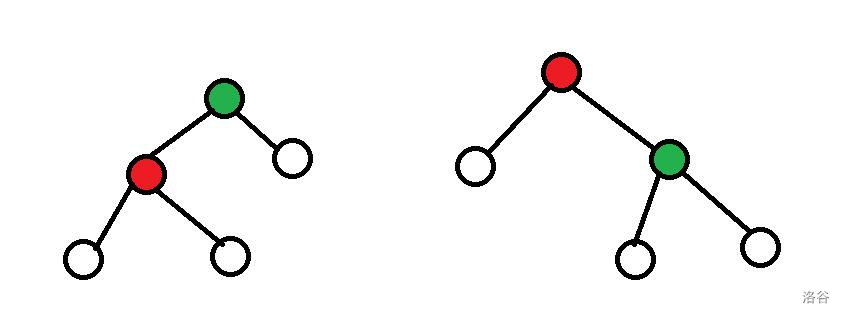
以下的都忽略 O(1) 常数
对于一次 zig 操作 : 定义$ \Delta\phi(T)=\phi(x’)+\phi(y’)-\phi(x)-\phi(y)=\phi(y’)-\phi(x)\leq\phi(x’)-\phi(x)$
对于 $\text{zig zag} $ 操作
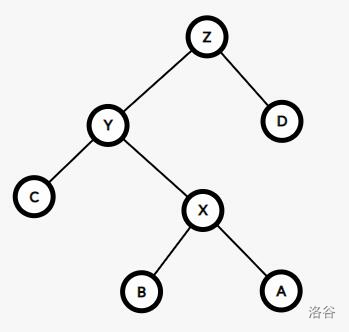
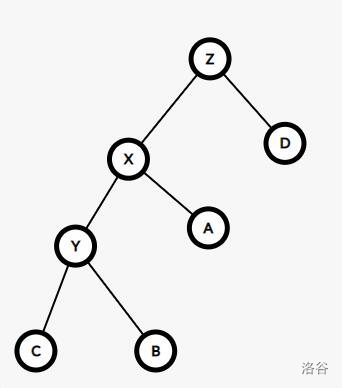
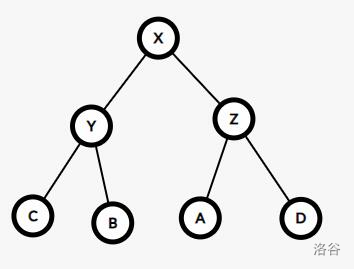
肉眼可见树的深度变小了,但是这不是平衡树
Δϕ(T)=ϕ(x′)+ϕ(y′)+ϕ(z′)−ϕ(x)−ϕ(y)−ϕ(z)=ϕ(y′)+ϕ(z′)−ϕ(x)−ϕ(y)≤ϕ(y′)−ϕ(z′)−2ϕ(x)=2(ϕ(x′)−ϕ(x))+(ϕ(y′)+ϕ(z′)−2ϕ(x′))≤2(ϕ(x′)−ϕ(x))
同理,我们看看 zig zig


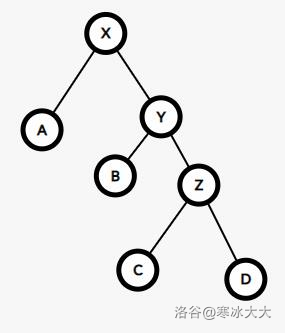
这时候的情况就稍微有一点不同了
Δϕ(T)=ϕ(x′)+ϕ(y′)+ϕ(z′)−ϕ(x)−ϕ(y)−ϕ(z)=ϕ(y′)+ϕ(z′)−ϕ(x)−ϕ(y)≤ϕ(x′)+ϕ(y′)−2ϕ(x)=3(ϕ(x′)−ϕ(x))+(ϕ(y′)+ϕ(x)−2ϕ(x′))≤3(ϕ(x′)−ϕ(x))
由于 zig 操作 不超过一次,因此复杂度显然是均摊 O(nlogn)











